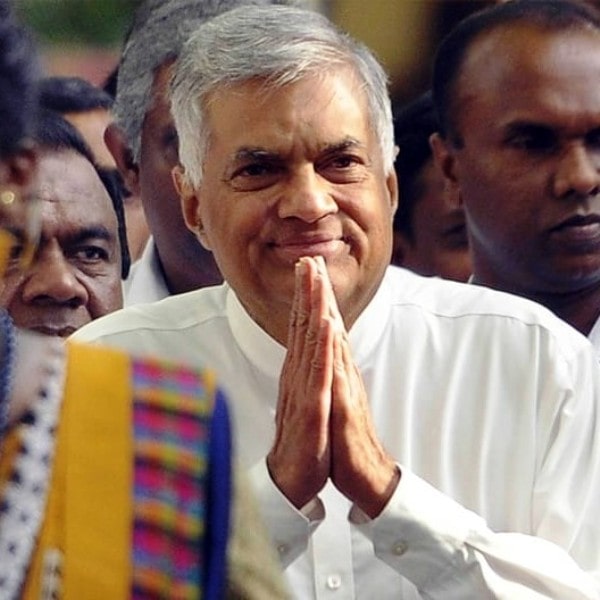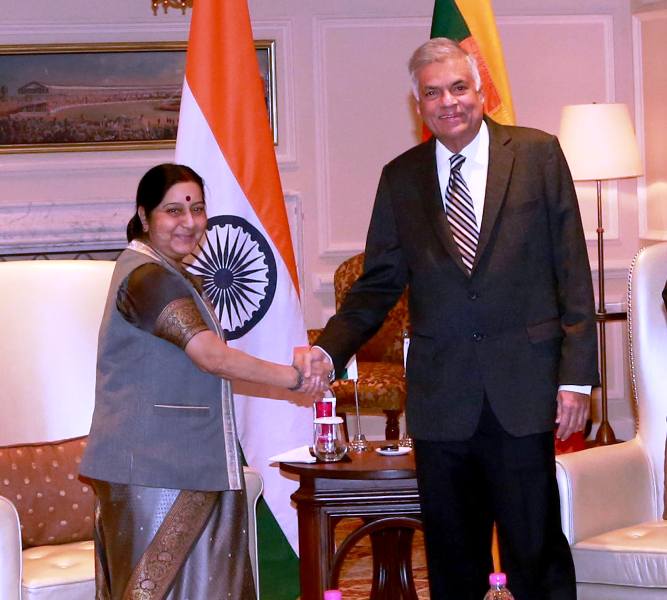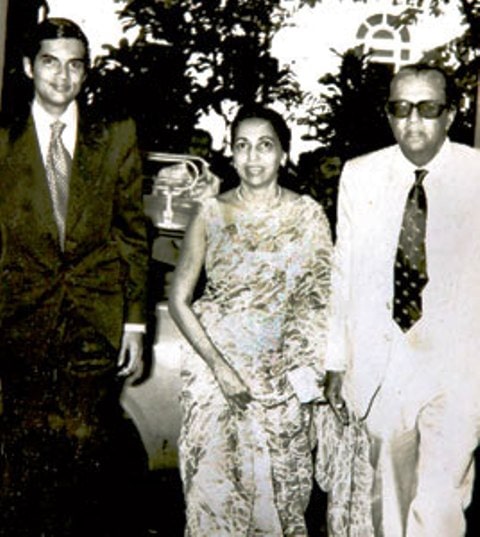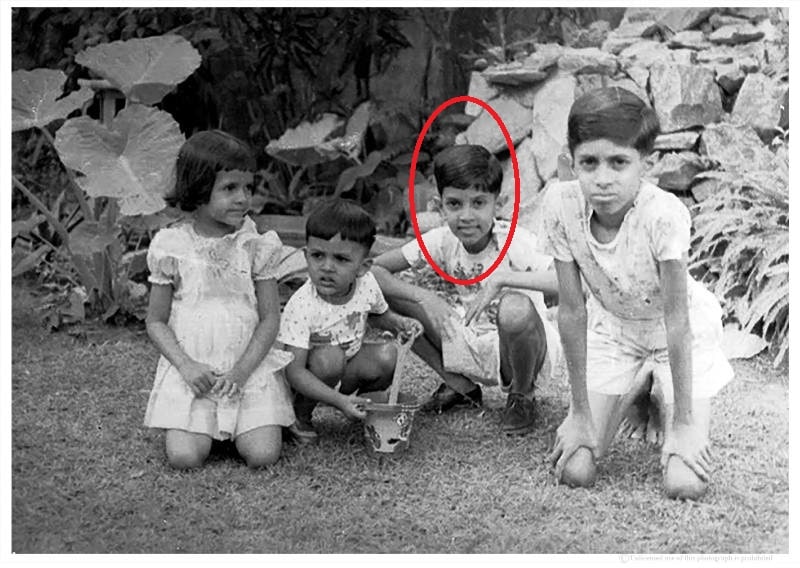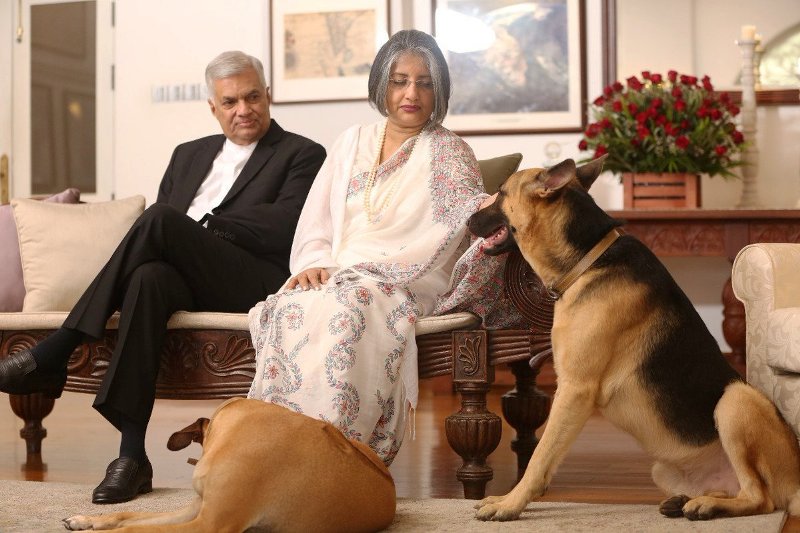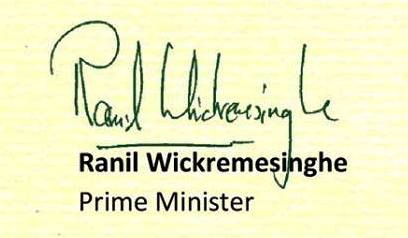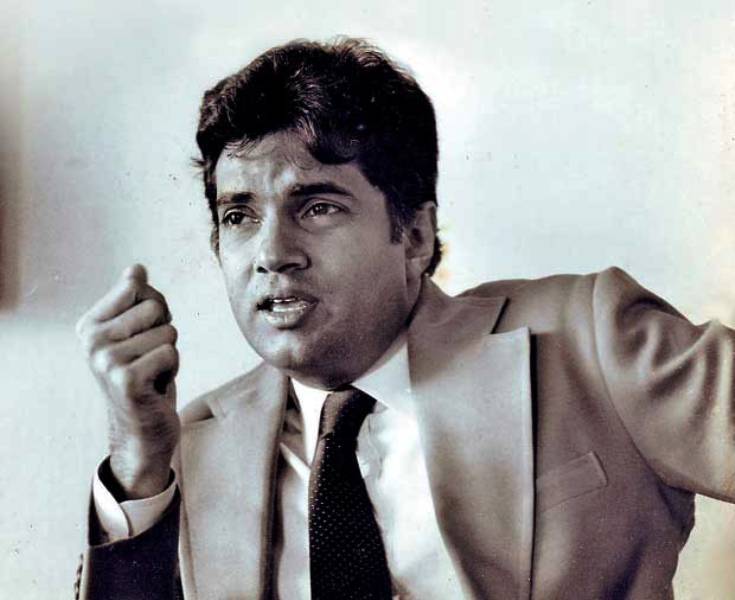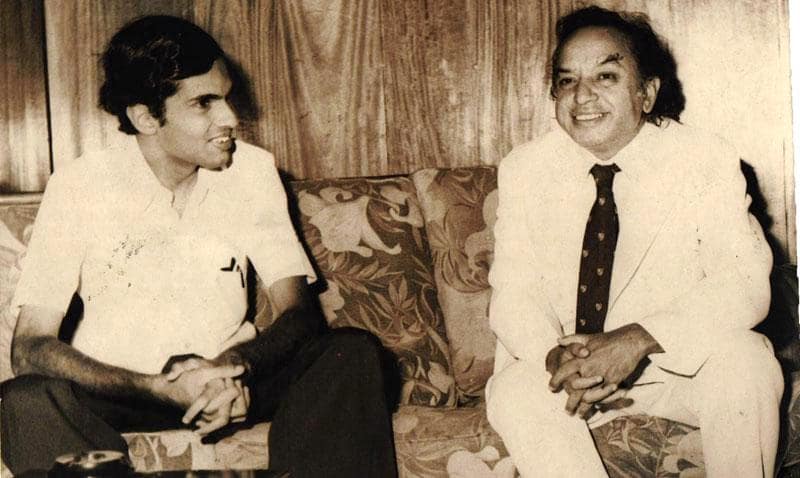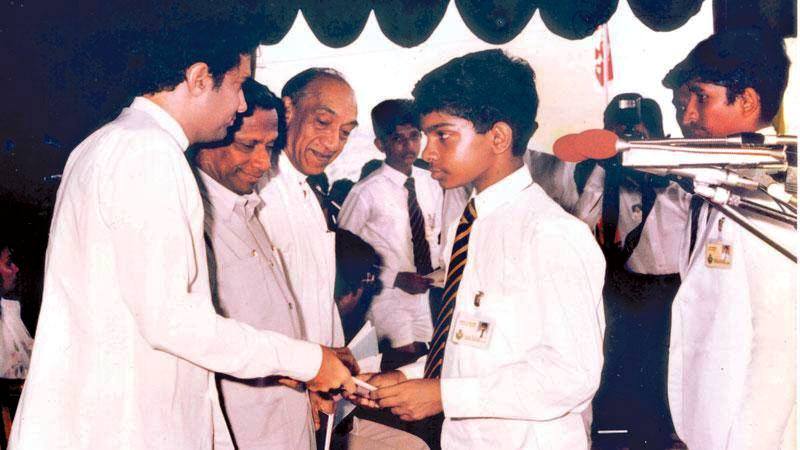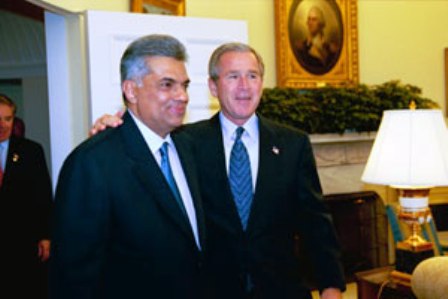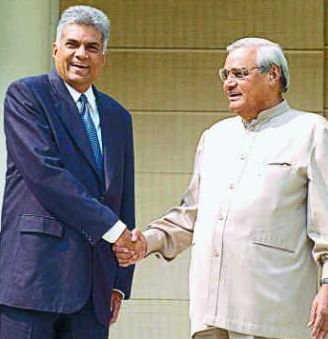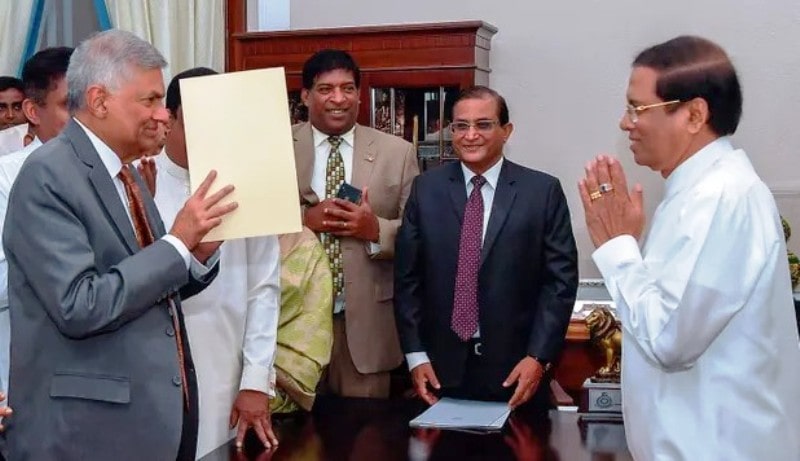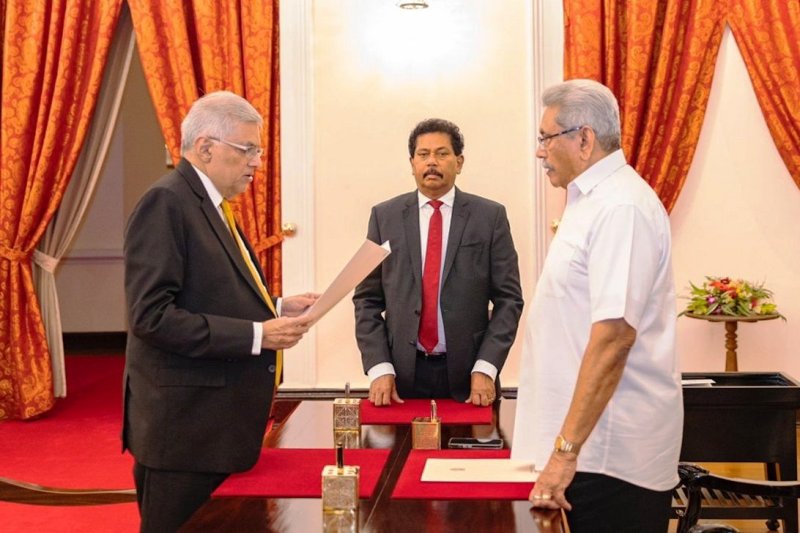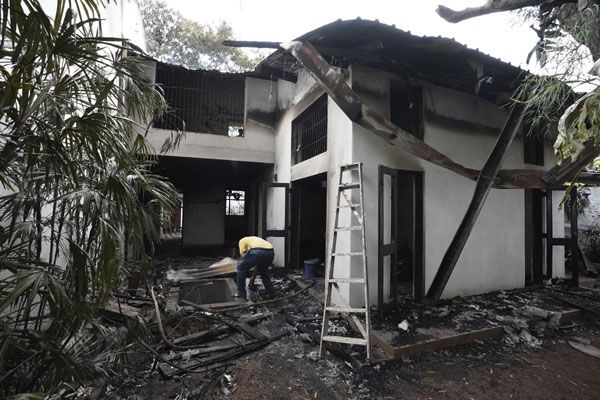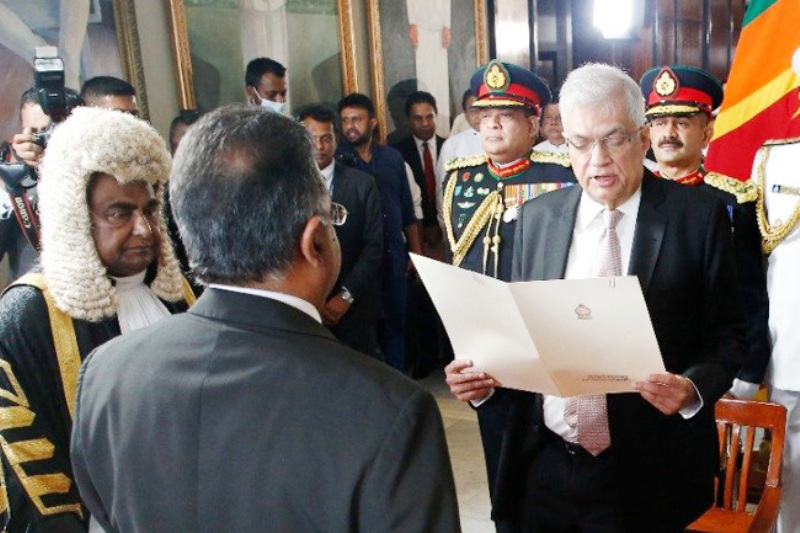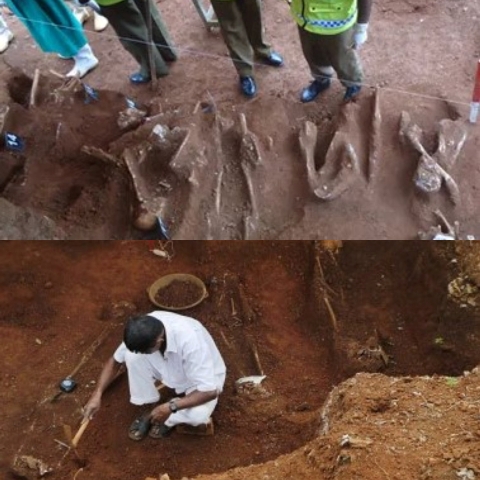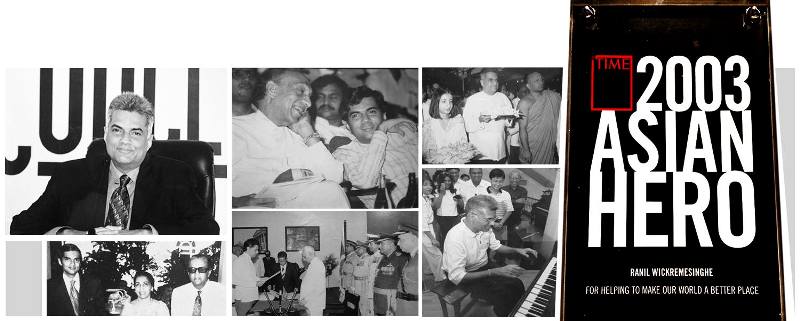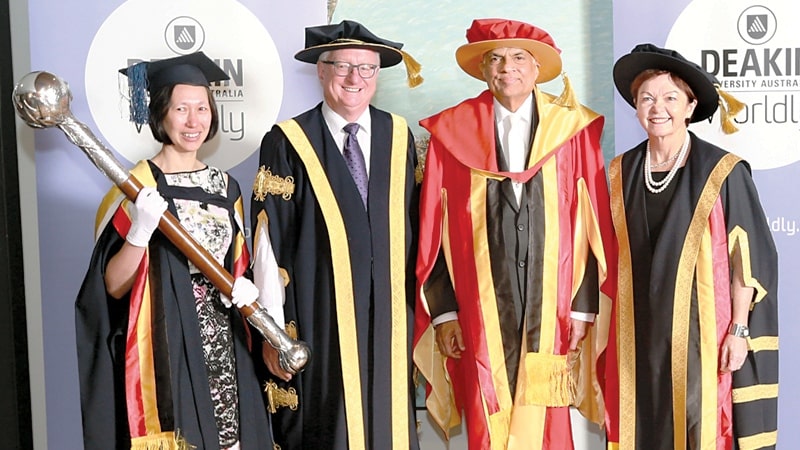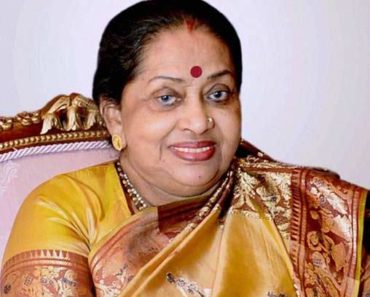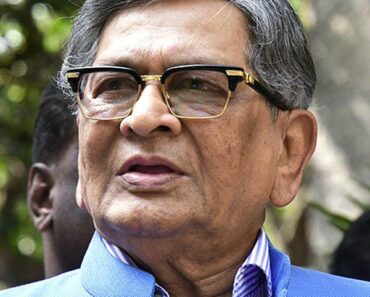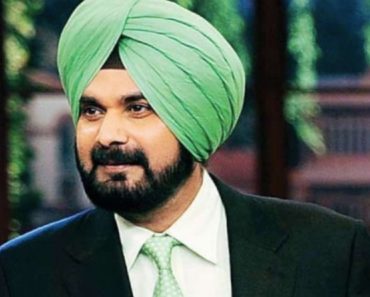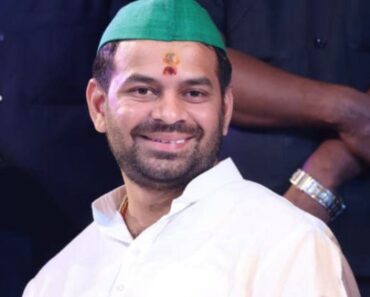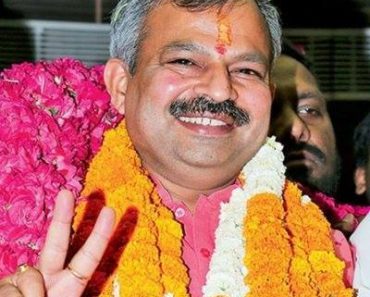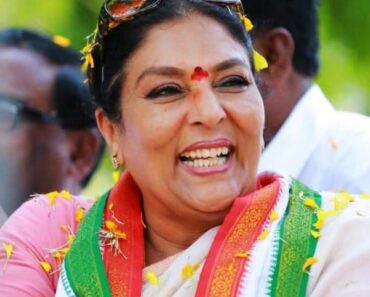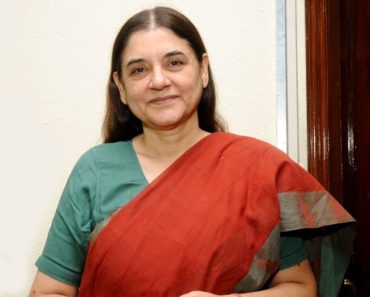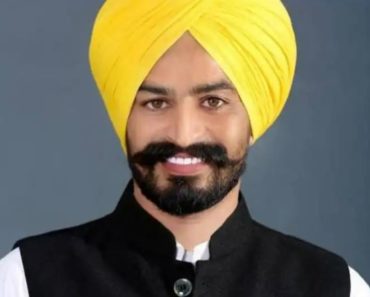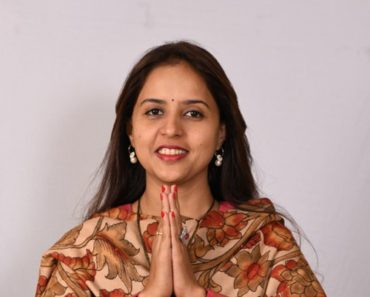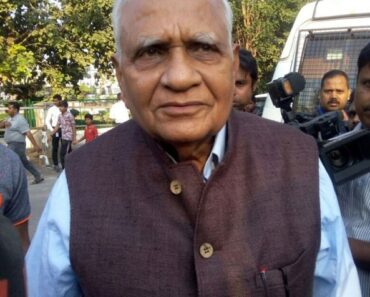Ranil Wickremesinghe is a Sri Lankan politician, lawyer, and member of the Sri Lankan parliament. In July 2022, he became the 9th President of the country. Earlier, he served as the Prime Minister of Sri Lanka six times.
Contents
Wiki/Biography
Ranil Wickremesinghe was born on Thursday, 24 March 1949 (age 73 years; as of 2022) in Colombo, Sri Lanka. Ranil completed his primary schooling at Royal Preparatory School and secondary schooling at Royal College, Colombo. After completing his schooling, he pursued LLB at the University of Ceylon (now the University of Colombo), and he graduated with a bachelor’s degree from the University in 1972. In 2014, he was enrolled at the Massachusetts Institute of Technology (MIT) as a Robert E. Wilhelm Fellow. [1]Daily Mirror
Physical Appearance
Height (approx.): 5′ 11″
Hair Colour: Salt and Pepper
Eye Colour: Dark Brown
Family
Ranil Wickremesinghe belongs to an affluent political and business family.
Parents & Siblings
His father, Esmond Wickremesinghe, was a lawyer and an eminent journalist. He was once appointed as the President of the International Press Institute and was awarded the Golden Pen of Freedom for his contribution to journalism. His mother, Nalini Wickremesinghe, played an important role in re-vitalising the Sinhalese drama.
He has three brothers and a sister. His brothers are named Shan, Niraj, and Channa. His sister’s name is Kshanika.
Wife
His wife, Maithree Wickramasinghe, is a professor in the Department of English and the Director of the Centre for Gender Studies at the University of Kelaniya. She is a well-known international speaker on gender and women studies. The couple tied the knot in 1995.
Religion
Ranil Wickremesinghe follows Buddhism. [2]Parliament of Sri Lanka- Ranil Wickremesinghe
Address
He resides at House No. 117, 5th Lane, Colombo – 03, Sri Lanka.
Signature
Career
Lawyer
Ranil Wickremesinghe, after earning a law degree in 1972, worked as an apprentice under the renowned Sri Lankan lawyer H. W. Jayewardene. In 1973, after completing his apprenticeship, Ranil Wickremesinghe began working as a lawyer in the Supreme Court.
Politics
Ranil Wickremesinghe’s career in politics began in the early 1970s when he joined the Youth League of the United National Party (UNP). In 1975, progressing through the ranks of the party, Ranil Wickremesinghe was appointed as the chief organizer during the Kelaniya by-elections in Sri Lanka. In 1977, during the Sri Lankan national elections, he was appointed as the chief organizer of the party in the Biyagama electorate from where he contested elections. In 1977, at the age of 28, Ranil Wickremesinghe won the national elections and became the youngest member of the parliament ever to hold a ministerial appointment. He was made a deputy minister of Foreign Affairs. [3]Business Standard
On 5 October 1977, he was made the minister of Youth Affairs & Employment. While serving as the minister of Youth Affairs & Employment, Ranil Wickremesinghe founded the National Youth Services Council (NYSC) to provide vocational training and career guidance to those who left education mid-way. On 14 February 1980, Ranil Wickremesinghe was given charge of the Education Ministry. As an Education Minister, Ranil worked on streamlining the distribution of books and other stationaries to the students. He also took several measures to stop the illegal appointment of teachers to government-run schools and colleges. He improved the standard of education by introducing educational TV and computers in schools.
After holding the office for nine years, Ranil Wickremesinghe was made the Minister of Industry in 1989. As a minister, in 1989, he brought several reforms to the industrial sector of Biyagama and established the Biyagama Special Economic Zone (B-SEZ). [4]WION In the same year, after defeating his political rivals Lalith Athulathmudali and Gamini Dissanayake, Ranil Wickremesinghe was appointed by the parliament as the Leader of the House. The following year, he was given the additional charge of the Ministry of Science and Technology.
A stint with the Prime Ministerial post
In 1993, the then President of Sri Lanka, Ranasinghe Premadasa, was assassinated by the Liberation Tigers of Tamil Eelam (LTTE) after which, on 7 May 1993, Ranil Wickremesinghe was appointed as the Prime Minister of Sri Lanka, while D. B. Wijetunga, a senior UNP leader, was made the President of the country.
Becoming the leader of the opposition
In 1994, in the national elections, the United National Party (UNP) lost against the People’s Alliance (PA). In the same year, Gamini Dissanayake defeated Ranil Wickremesinghe by a margin of two votes and was made the leader of the opposition. By winning the post of the leader of the opposition, Gamini became a “by-default” Presidential choice of the UNP; however, later in 1994, Gamini was assassinated by the LTTE, and after his assassination, his widow, Srima Dissanayake, was chosen as the Presidential candidate by UNP. In the 1994 Presidential Elections in Sri Lanka, Srima Dissanayake was defeated by Chandrika Kumaratunga, the People’s Alliance (PA) Presidential candidate, by a margin of 35% of votes. After the loss in the Presidential elections, Srima resigned from the post as the leader of the opposition, and Ranil Wickremesinghe was once again appointed by the UNP as its leader. In the 1999 Presidential elections, Ranil Wickremesinghe was made the presidential candidate of the UNP against the People’s Alliance (PA) candidate Chandrika Kumaratunga. Before the elections, massive electoral rallies took place in the North-Western Provinces (NWP) of Sri Lanka. When one such rally was being held by Chandrika Kumaratunga, the LTTE detonated a bomb, which resulted in Chandrika losing her right eye. After the incident, there was a wave of sympathy for Chandrika among the Sri Lankan public, and the public voted for Chandrika in the 1999 Presidential elections. Ranil Wickremesinghe was defeated by Chandrika Kumaratunga by a margin of 51% of the votes. In 2000, during the parliamentary elections, Ranil Wickremesinghe led the UNP unsuccessfully against the People’s Alliance (PA); losing the elections.
Becoming a Prime Minister for the second time
In 2001, in the general elections, Ranil Wickremesinghe-led UNP managed to secure a total of 109 seats, while the People’s Alliance (PA) secured a total of 77 seats. Upon winning the 2001 general elections, Ranil Wickremesinghe became the Prime Minister and took oath as the 17th Prime Minister of Sri Lanka. This led to a conflict in the political arena as it severely limited the President’s power because both Prime Minister and the President, belonged to different political parties. Soon after becoming the Prime Minister, Ranil Wickremesinghe initiated the Western Region Megapolis, which aimed at building a large city in the Western province of Sri Lanka with modern amenities, which would make Sri Lanka’s standard of living equivalent to that of western countries. The project was initiated with the assistance of the engineers and architects of CESMA; a Singaporean firm. The project was stopped in 2004 after the UNP government lost the general elections.
Gathering international support in the war against LTTE
The war between LTTE, a separatist faction, and the government of Sri Lanka led to a massive loss of human lives and infrastructure in the country. In 2002, Ranil Wickremesinghe visited the White House to meet George W. Bush, the then President of the United States of America, to gather the U. S. support in the war against the LTTE. He became the first Prime Minister of Sri Lanka since 1984 to meet the President of the United States. In an interview, after the meeting, Ranil Wickremesinghe said,
When the President says he is behind you, that means a lot. We came here to discuss mainly about the peace process in Sri Lanka — and I got all the support I want for that. President Bush and the US government have encouraged us to go ahead with the political process to bring peace to Sri Lanka, a peace based on equality, human rights, rule of law, in other words democracy. The backing he has given me has been a tremendous help.”
In 2003, the Tokyo Donors Conference was held between Sri Lanka and Japan, where Ranil Wickremesinghe asked for the world’s support in rebuilding the nation. In his support, several countries, in total, donated approximately $4.5 billion to Sri Lanka. [5]Ada Derana To gather more economical assistance during the crisis in Sri Lanka, Ranil Wickremesinghe drafted several new foreign policies, which aimed at fostering better and closer relations with the West. His policies had a deeper impact on European countries, especially Norway, which gave maximum financial assistance to Sri Lanka during the Sri Lankan civil war than any other country. [6]India’s Foreign Policy: Challenge of Terrorism: Fashioning New Interstate Equations by Jyotindra Nath Dixit To gather more support in the favour of the Sri Lankan government, he met the Prime Ministers of the UK and India.
Entering a Ceasefire Agreement (CFA) with the LTTE
Ranil Wickremesinghe, in an interview, said that the only way to end the civil war in Sri Lanka was to peacefully resolve the issues that led to the beginning of the war. On 22 February 2002, a few months after taking over as the Prime Minister of Sri Lanka, he entered into a Ceasefire Agreement (CFA) with the separatist group LTTE. The agreement was signed under the facilitation of Norwegian Ambassador Jon Westborg. [7]Daily FT According to the agreement, both the Sri Lankan Armed Forces (SLAF) and the LTTE, decided to immediately stop their aggressive military operations in the country, which had caused a huge loss of life and material. The agreement also laid down the provision for establishing an international peace monitoring group called the Sri Lanka Monitoring Mission (SLMM). As a result of signing the agreement, the situation in Sri Lanka became peaceful, which led to an increase in tourism in the country. The A9 highway, which was closed due to the civil war in Sri Lanka, was re-opened after 18 years.
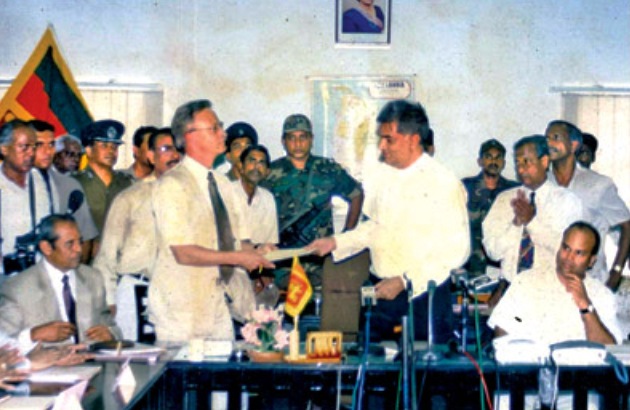
Ranil Wickremesinghe handing over the ceasefire agreement to Jon Westborg, the then Norwegian Ambassador to Sri Lanka
The other side of the Ceasefire Agreement
After the signing of the CFA, many political analysts believed that the agreement was a false front poised by both the government as well as the LTTE to strengthen their positions as well as their militaries. In 2003, Ranil Wickremesinghe visited the United States several times to request military assistance in terms of military training, military technology, intelligence, special training in counter-terrorism, and direct monetary assistance for military development. The United States military also sent a team from their Asia-Pacific Command to Sri Lanka to conduct an in-depth analysis of their military’s capabilities, highlight their weaknesses, and recommend steps to address those weaknesses. In 2003, the United States Coast Guard (USCG) donated their ship, SLNS Samudura, to the Sri Lankan Navy. The LTTE, on the other hand, had indulged in peace talks to buy more time to smuggle more arms, ammunition, and aircraft into their inventory. According to a report submitted by the SLMM in 2007, the LTTE was accused of violating the CFA on 3830 occasions, whereas the Sri Lankan government violated the CFA’s guidelines only on 351 occasions. [8]LankaWeb In an interview, the former Minister of Foreign Affairs of Sri Lanka Lakshman Kadirgamar, said,
During the ceasefire period, the LTTE was infamous for using violent means including suicide bombers, smuggling in 11 shiploads of weapons, forcibly conscripting adults and children, torturing, extorting and denying democratic and fundamental rights to the trapped civilians within the illegally usurped territory.”
During this phase, the LTTE was accused several times of killing or kidnapping Sri Lankan Army’s intelligence officers, including the then commanding officer of Army Intelligence (AI) Colonel Tuan Nizam Muthaliff. [9]Gulf News
Dissolving the parliament
On 7 February 2004, citing a threat to the national sovereignty due to the decision of the UNP members of parliament to join the LTTE’s Interim Self Governing Authority (ISGA), President Chandrika Kumaratunga dissolved the parliament which ended the UNP-led national government’s reign over the country.
Becoming the Leader of the Opposition for the second time
In 2004, after the parliament was dissolved by President Chandrika Kumaratunga, national elections were held in Sri Lanka in which the Wickremesinghe-led UNP lost the elections to United People’s Freedom Alliance (UPFA). Since Ranil Wickremesinghe was the leader of the opposition, he became a “by-default” choice of the UNP as its Presidential candidate for the 2005 Presidential elections; however, in 2005, the Supreme Court of Sri Lanka decided to postpone the elections for a few months due to a rapid increase in violence in the country. The Presidential elections were conducted in August 2005 in which Ranil was defeated by the Sri Lanka Freedom Party’s (SLFP) Presidential candidate Mahinda Rajapaksa by a narrow margin of 2% of votes. It is believed that Mahinda Rajapaksa won the elections as the LTTE had issued an ultimatum in the Northern and Eastern parts of Sri Lanka to boycott the elections as a result of which the Tamil population, which was a minority in those areas, could not cast their votes. [10]The Guardian Expressing his dissatisfaction over the entire electoral process, Ranil Wickremesinghe said,
It is a setback for the peace process as you have a very divided society. There is no Sri Lankan mandate but a divided one. I have demanded a recount of the vote in parts of the country where Tamil militants had prevented an estimated 500,000 voters from reaching polling stations, but the request was rejected by Sri Lanka’s elections commissioner.”
After the defeat of the LTTE in 2007, provincial elections were held in several parts of Sri Lanka between 2008 to 2009. In the provincial elections, the UNP was defeated by the UPFA by a margin of 2,527,783 votes. In 2009, Ranil formed an alliance with twelve other political parties against the UPFA for the 2010 Presidential elections. The coalition announced Sarath Fonseka, a retired Sri Lankan Army General, as their Presidential candidate. [11]Al Jazeera
Disagreement among the prominent leaders of the party
In 2007, Ranil Wickremesinghe signed a Memorandum of Understanding (MOU) with the SLFP in which he agreed to support the SLFP in the parliament on matters pertaining to the national interest; however, this act of Ranil angered the UNP MPs, who defected to the UPFA, which was ruling at that time. Out of 60 UNP members of parliament, 17 left the party, including the party’s deputy leader Karu Jayasuriya. The defected members were later on given a ministerial appointment in the UPFA government. In 2008, Karu Jayasuriya defected back to the UNP, and he was re-appointed as the deputy leader of the party. [12]The Sunday Times
Distrust among the party members
In 2008, owing to the mass defection of UNP MPs, Ranil Wickremesinghe was forced by the remaining UNP MPs to step down from his appointment as the opposition leader and accept the post of party advisor. In March 2008, after deliberation, the party’s working committee decided to create a new post of senior party leader for Ranil Wickremesinghe, so that he could step down from the party’s leadership. Later in 2008, the party’s working committee and the party’s parliamentary group decided that Ranil Wickremesinghe should continue to hold the position of the party’s leader.
Becoming a Prime Minister for the third time
In 2013, the coalition, led by Ranil Wickremesinghe, signed a memorandum of understanding with the SLFP to field the SLFP’s general secretary Maithripala Sirisena as the coalition’s Presidential candidate for the 2015 Presidential elections. Maithripala Sirisena was fielded as the presidential candidate only on one condition, i.e., after winning the elections, he would appoint Ranil Wickremesinghe as the Prime Minister. The elections were held on 8 January 2015 in which Maithripala Sirisena emerged victorious. After winning the elections, he appointed Wickremesinghe as the Prime Minister of the country. [13]Indian Council of World Affairs
Improving the foreign relations
After becoming the Prime Minister for the third time, Ranil Wickremesinghe forged several alliances with the regional powers like India and China. His main aim was to re-balance the Indo-Sri Lanka relationship by resolving the fishing dispute in the Palk Strait. While engaging in the talks with India, Ranil defended the use of lethal force by the Sri Lankan Navy against the Indian fishermen, and he also justified the shooting of the fishermen. He further claimed that the Sri Lankan government is open to a “reasonable” talk with the Indian government. [14]The Hindu While justifying his statement, Ranil, in an interview, told,
If someone tries to break into my house, I can shoot. If he gets killed…Law allows me to do that… On the fishermen issue, As far as I’m concerned, I have very very strong lines. This is our waters…Fishermen of Jaffna should be allowed to fish. We stopped them from fishing, That’s Why the Indian fishermen came in,, They are willing to have a deal…Let’s have a reasonable deal..But not at the expense of the income of the Northern Fishermen…No…”
Many international political observers claimed that the policies made by Ranil Wickremesinghe as a Prime Minister were different from the “isolating” policies of his predecessors. After getting elected as the Prime Minister of Sri Lanka, he visited Japan and Singapore to bolster ties with them. When he visited Japan, Ranil pledged that Sri Lanka would support Japan’s bid for the United Nations Security Council (UNSC) membership, and when he visited Singapore, he invited the Singaporean Navy to pay a friendly visit to the country.
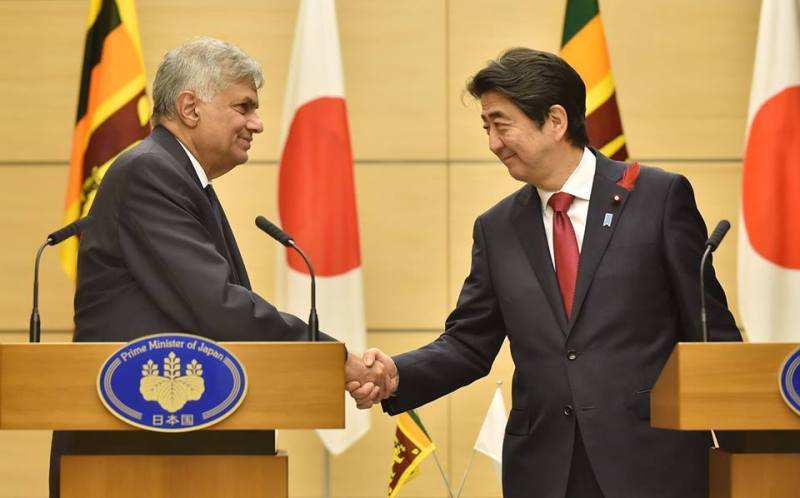
Ranil Wickremesinghe shaking hands with the former PM of Japan Shinzo Abe, who was assassinated in 2022
Serving as the Prime Minister for the fourth time
In 2015, general parliamentary elections were held ten months before the schedule in Sri Lanka. The results of the elections were declared on 17 August 2015. In the elections, Ranil Wickremesinghe-led UNP managed to secure 106 out of 225 seats. Ranil defeated Mahinda Rajapaksa, who led the UPFA, by a margin of 5,00,556 votes; creating a record of defeating a political rival by a margin of the highest number of votes in the history of Sri Lanka. [15]Fast News Upon getting elected as the Prime Minister, Ranil Wickremesinghe announced the government’s resolve to create one million jobs for unemployed citizens. In 2015, he passed several bills, which were aimed at improving the economy. In the same year, he passed a bill in which he reduced the tax slab for the poor to enhance their standard of living. [16]Daily Mirror While giving an interview with a newspaper, he said,
We have given a lot of benefits and relief for the people through this budget. . . Our aim is to lend a helping hand for everyone to prosper economically irrelevant of their political affiliations and it is pointless to become multi-millionaires if that money has been earned by heavily taxing the poor and through corrupt deals. I am not a person who hugs and embraces children, but I will ensure that their futures are secure. This country has to be completely turned around from its present plight – the eduation and health sectors have to be developed and there is a need to generate over one millioin jobs for the youth.”
In 2015, he visited the war-torn areas of Sri Lanka to gather first-hand information on the issues faced by the civilians living in such areas. He also passed several bills in the parliament which were aimed at improving the living conditions of the people in war-affected areas by providing employment, improving medical facilities, and establishing industries. During the Sri Lankan civil war, many innocent civilians went missing. The authorities, during the reign of the previous governments, did not take any action to find the information regarding the missing people. After getting elected to power, Ranil Wickremesinghe announced that the information on all the missing citizens would be provided to their families within six months. In an interview, Ranil said,
The government will restart the industries that were destroyed during the war to provide employment to the people in the area and all the investigations with regard to missing persons would be completed by the relevant authorities within 6 months and the details would be handed out to their respective families.”
In October 2015, Ranil Wickremesinghe revived the Western Region Megapolis project. At the Sri Lankan government’s request, the project’s old plans were revised by a Singaporean firm named CESMA. As per the new plan, the project would provide housing facilities to approximately eight million people, and it would overcome the modern problems of traffic congestion, waste management, and slum dwelling. According to the revised plans, it was expected that the project would be completed by 2030. In an interview, Ranil told the media,
Singapore’s Cesma did the planning in 2004, but it was not followed up by President Rajapaksa. Now, we have got them to revise the plan. It will be available by the end of the year. We also want them to do the master plan for Trincomalee.”
In November 2015, Ranil Wickremesinghe presented a Medium-term Policy Framework to bring the desired economic impact. The bill emphasised creating a knowledge-based economy and strengthening the country’s healthcare sector. The bill also aimed at increasing exports to decrease the income disparity in the country. The bill, to increase the output of the State Owned Enterprises (SOEs), also laid down the norms based on which a new managerial staff would be hired to eliminate the corrupt practices of employees and politicians. The bill also laid an emphasis on entering favourable trade pacts with India and China, attaining the GSP+ status from the European Union, improving tourism, establishing Special Economic Zones (SEZs), rural economic development, and a lot more. Despite the measures undertaken by Ranil, Sri Lanka recorded a mere economic growth of just 3.1%; the lowest since 2001. In a statement given by the Central Bank of Sri Lanka, it claimed that despite a lower economic growth rate, the country recorded a sharp decrease in unemployment. The CB also claimed that the agricultural sector showed signs of recovery and improvement in the fourth quarter of 2017. The study conducted by CB also showed an improvement in the demand and supply ratio in the country. [17]Times Online In 2015, when Ranil Wickremesinghe took over as the Prime Minister of Sri Lanka, he had to deal with the corruption and lawlessness left behind by the ministers and high-ranking appointment holders of the Rajapaksa-led SLFP. To investigate the matters of corruption, Ranil created an anti-corruption department called Financial Crimes Investigation Division (FCID). A few months after establishing the FCID, Basil Rajapaksa, younger brother of Mahinda Rajapaksa, was arrested on the charges of laundering $5,30,000; while serving as the Minister of Economic Development. [18]BBC In an interview, while clarifying the issue, Basil said,
They have no evidence. They are making wild allegations. This is a witch hunt. Neither I nor any member of my family has ill-gotten money.”
Ranil Wickremesinghe was criticised and accused by the opposition of using the FCID for his agenda of hunting the members of the Rajapaksa family by framing false charges against them.
Forced to step down
In 2018, the Wickremesinghe-led UNP suffered a massive defeat in the local authority elections held in Sri Lanka. In the elections, out of a total of 340 seats, the UNP managed to secure only 34 seats. The defeat in the local elections led to resentment among the UNP members of parliament, who demanded that Ranil must step down from the post of Prime Minister. The then President of Sri Lanka, Maithripala Sirisena, also asked Ranil Wickremesinghe to resign from the appointment; however, the request of the President was rejected by Ranil. [19]MENAFN On 26 October 2018, after the withdrawal of the UPFA from the coalition government, the UNP-led government collapsed as a result of which President Maithripala Sirisena appointed Mahinda Rajapaksa as the country’s new Prime Minister.
The constitutional crisis and Ranil’s reappointment as the Prime Minister
On the evening of 26 October 2018, Ranil Wickremesinghe was informed by the President about his removal from office, and the appointment of Mahinda Rajapaksa as the new Prime Minister. Ranil called the appointment of Mahinda Rajapaksa unconstitutional and refused to resign from the post. Since there were two in-office Prime Ministers, in 2018, this triggered a constitutional crisis in Sri Lanka. The act of President Sirisena was widely criticised by the international community. [20]Scroll.in Following the “unlawful” removal from the office, Ranil Wickremesinghe filed litigation in the Supreme Court. On 16 December 2018, the court delivered its judgement in favour of Ranil and asked the President to reinstate him as the Prime Minister of Sri Lanka. After being appointed as the PM, Mahinda Rajapaksa not only failed to gather the support of the MPs but also failed to pass the motion of confidence. On 1 January 2019, Ranil Wickremesinghe was re-appointed as the Prime Minister of Sri Lanka and began his fifth tenure as the Prime Minister. [21]Reuters In an interview, Ranil said,
It is a victory for Sri Lanka’s democratic institutions and the sovereignty of our citizens. I thank everyone who stood firm in defending the constitution and ensuring the triumph of democracy. I will work for a better economic situation, better standard of living for Sri Lankans after first working to normalize the country.”
2020 General elections
In 2020, parliamentary elections were held in Sri Lanka in which Wickremesinghe-led UNP suffered a massive defeat by the Rajapaksa-led Sri Lanka People’s Front (SLPF). Ranil’s party managed to secure only 2.5% of the total votes in the elections. The party did not succeed in winning a single seat in the parliament. It could only manage to secure a seat from the national list. [22]Ada Derana On 23 June 2021, Ranil Wickremesinghe entered the parliament as a member of parliament from the national list. [23]News First
Taking over the Prime Ministership for the sixth time
Upon failing to repay the loans taken from many other countries, on 12 April 2022, the country declared itself a sovereign default state. Soon after the declaration, out of the 225 members of the parliament, 160 MPs demanded that Ranil Wickremesinghe should be made the Prime Minister of the country due to his economical knowledge and experience in dealing with the International Monetary Fund (IMF). In an interview, an MP said,
He is being sworn in as the prime minister … because a number of members of parliament have asked him to take over and solve the country’s problems.”
On 12 May 2022, Ranil was sworn in as the Prime Minister of the country by Gotabaya Rajapaksa. While giving an interview, Ranil said that he took over as the country’s Prime Minister to solve the economic crisis, and not to hold a ministerial appointment in the government. He said,
No, no, I’m only getting involved in the sense of helping to resolve some of the economic issues from the outside, I’m not joining the government as a minister or anything. That leaves me free. I have no interest except to make sure people are fed and parliament takes control of the situation. We want to return the nation to a position where our people will once again have three meals a day. Our youth must have a future.”
On 25 May 2022, Ranil Wickremesinghe was given an additional charge as the Minister of Finance, Economic Stability and National Policies. [24]The Hindu After his residence was burned by the angry protestors, on 9 July 2022, Ranil Wickremesinghe offered to resign from the post of Prime Minister but only after a new government was formed in the centre. [25]Al Jazeera In an interview, Ranil claimed,
I respect the rights of the protesters to peacefully undertake their demonstrations, but I will not allow another government building like the Presidential Palace or the Prime Minister’s private residence to be occupied. Today in this country we have a fuel crisis, a food shortage, we have the head of the World Food Programme coming here and we have several matters to discuss with the IMF. Therefore, if the people want, I shall resign, but only when there is another government in place.”
When his house was attacked by the protestors, they completely ransacked his home and stole a total of 1000 artefacts. The protestors also burned more than four thousand books and destroyed a 125-year-old piano. [26]The Hindu
Taking over as the 9th President of the country
After Gotabaya Rajapaksa resigned from his Presidency and fled to the Maldives, Ranil Wickremesinghe was appointed as an acting President of Sri Lanka. He was sworn in on 15 July 2022 by the Chief Justice of Sri Lanka. After taking over the Presidency, Ranil appointed himself as the Prime Minister, Minister of Defense, Minister of Technology, and Minister of Finance. On 20 July 2022, Ranil Wickremesinghe became the 9th President of Sri Lanka by defeating his rival, Dullus Alahapperuma, by securing a total of 134 votes in a secret ballot voting that took place in the parliament. [27]BBC
Controversies
Accused of playing a role in the Batalanda massacre
From 1987 to 1989, Janatha Vimukthi Peramuna (JVP) started an armed communist movement in Sri Lanka in which the members of the JVP began attacking civil and military targets. In 1987, a resolution was passed by the UNP-led government, which allowed for a counter-insurgency program to be started by the Sri Lankan Armed Forces (SLAF) to curb the armed movement. In 1996, Ranil Wickremesinghe, who was a minister of industries in 1988, was accused by the People’s Alliance (PA) of being the political authority that sanctioned the construction of several illegal torture and detention centres at Batalanda under the cover of Batalanda Housing Scheme (BHS). At the detention centres, many JVP members and civilians, accused of collaborating with the JVP, were brutally tortured and killed. The PA also accused Ranil of establishing an illegal covert police intelligence unit, tasked with kidnapping and torturing innocent people. [28]LankaWeb In 1997, a fact-finding commission was established by President Chandrika Kumaratunga. On 3 September 1997, Ranil Wickremesinghe was summoned by the Special Presidential Commission of Inquiry over his alleged role in the massacre. After conducting a thorough inquiry, the commission submitted its report to the President on 12 April 1998. In its report, the commission called for “bringing the guilty to book.” The commission also stated that Ranil, as a minister, had abused the power by conducting unconstitutional meetings with the police officials involved in the counter-insurgency operations against the JVP. The commission in its report said that “Ranil Wickremesinghe and SSP Nalin Delgoda were indirectly responsible for the maintenance of places of unlawful detention and torture chambers in houses at the Batalanda.” The commission also found out that there were many unmarked graves, where the tortured victims were burnt and then buried by the law enforcement authorities. [29]Sinhalanet.net Since the commission did not have judicial powers, no case was registered by the authorities against the accused. [30]Report of the Commission of Inquiry Into the Establishment and Maintenance of Places of Unlawful Detention and Torture Chambers at the Batalanda Housing Scheme
Accused of being a dictator
In 2010, Ranil Wickremesinghe was accused by several senior party leaders of following a dictatorial pattern in the party. A senior UNP leader and former MP Udugama Sri Buddharakkitha Thero said that the actions of Ranil Wickremesinghe were no less than the actions of a dictator. He also accused the party president of being undemocratic as he does not listens to what other members of the party have to say. Former MP Mahinda Wijesekara also accused Ranil of dictatorship and said that the party’s president rejected the much-needed reforms in the party. He also said that the “party does not need a dictator among its ranks,” and that he was unjustifiably thrown out of the party for voicing his opinion against Ranil. In an interview, he said,
He can manage the crisis but he will remain in the opposition forever, unless he implements reforms.The majority in the party have agreed to decentralise power. Even after we joined, still the UNP could not grab power. Who are the leaders in this party other than us? Persons who have gone to Royal College cannot bring the party back to power. We don’t need a dictator in the party. I am one of the nine members who came to the UNP giving up Ministerial portfolios. But today I have been sidelined.”
Central Bank bond scam
In 2015, while serving as the Prime Minister, Ranil Wickremesinghe was brought under the lens of a Presidential commission that was investigating a fraud in which bonds were sold by the Central Bank of Sri Lanka (CBSL) to the highest bidder at a much higher interest rate because of which the Government of Sri Lanka incurred loses worth $10.6 million. The governor of the CBSL was accused of selling the bonds to his son-in-law’s company named Perpetual Treasuries Limited. In 2017, Ranil was summoned by the inquiry commission for testification against the scam. The opposition party alleged that Ranil Wickremesinghe was acutely aware of the transactions, and he was summoned by the commission over his role; however, the UNP came to the defence of Ranil and stated that the Prime Minister was not summoned, he appeared “voluntarily” before the commission. [31]The Hindu
Accused of using the name of a slain journalist to win elections
In 2009, Lasantha Wickrematunga, the founder of the leading Sri Lankan newspaper The Sunday Leader was killed by some assailants while he was on his way to the office. Gotabaya Rajapaksa was blamed for orchestrating the attack on the journalist as the slain journalist often wrote against and criticised Rajapaksa-led SLFP in his articles. In 2019, Lasantha’s daughter, Ahimsa Wickrematunga, accused Ranil Wickremesinghe of using her father’s name to gather votes. She also accused him of breaking the promise of providing speedy justice to the Wickrematunga family once Ranil got elected as the Prime Minister of the country. She further accused Ranil of covering Rajapaksa by not taking any form of action against the former President. [32]The Hindu In a letter, Ahimsa wrote,
From the day my father died, you have invoked his name to win votes. My father’s murder was a prop in the 2015 parliamentary and presidential elections that made you Prime Minister. You brought President (Maithripala) Sirisena to power and won control of parliament by promising justice for my father’s murder.”
A violent crackdown on the protestors
In July 2022, soon after taking over as the President of Sri Lanka, Ranil Wickremesinghe declared a nationwide emergency and ordered a crackdown on the “fascist” protests being staged by the citizens of Sri Lanka against the economic and political turmoil in the country. On the morning of 22 July 2022, the law enforcement agencies initiated a crackdown on the protestors in Galle Face Green, which led to over fifty protestors being injured and two getting admitted to the hospital for severe trauma. The BBC journalists, who were covering the event were also brutally attacked by the law enforcement agencies which led to many journalists getting severely injured and hospitalized. Justifying the need for a crackdown, Ranil, in an interview, said,
Peaceful protests are accepted, however, there are some who are engaged in acts of sabotage…There are fascist groups that are trying to incite violence in the country. Such groups snatched weapons and ammunition from the soldiers recently. 24 soldiers have… If you try to topple the government, occupy the president’s office and the prime minister’s office, that is not democracy; it is against the law. We will deal with them firmly according to the law. We will not allow a minority of protesters to suppress the aspirations of the silent majority clamouring for a change in the political system.”
The international community expressed its anguish over the brutal crackdown on the journalists in the country. The British Ambassador to Sri Lanka, Sarah Hulton, also expressed her concerns over the events that unfolded on 22 July 2022. [33]The Guardian
Salary
As of July 2022, his salary as the President of Sri Lanka, his salary was 90,000 Sri Lankan Rupees + other allowances. [34]LankaNewsWeb
Facts/Trivia
- In 2003, an article on Ranil Wickremesinghe was published in Time Magazine.
- In 2017, for his contribution to the fields of economy, education, and human rights, Ranil Wickremesinghe received an honorary doctorate from Deakin University in Australia.
- Apart from holding political posts in Sri Lanka, Ranil Wickremesinghe also held the non-political posts of vice chairman in the International Democrat Union (IDU) and chairman in the Asia Pacific Democrat Union (APDU).
- In 2017, Ranil Wickremesinghe signed a 99-year lease agreement with a Chinese firm, which allowed them to have 80% control over the port of Hambantota. The signing of the lease resulted in widespread protests in Sri Lanka. [35]ABC News The leader of the protests, MP Chanaka, in an interview, said,
We are against leasing the lands where people live and do their farming, while there are identified lands for an industrial zone. When you give away such a vast area of land, you can not stop the area from becoming a Chinese colony.”
- In July 2022, after becoming the President of Sri Lanka, Ranil Wickremesinghe abolished the honorific prefix of “His Excellency,” which was given to the President. He also abolished the use of the Presidential flag. [36]Deccan Herald In an interview, he said,
I have been against the use of the term “His excellency” since day one. The post of the President is not above anything or anyone, especially the constitution of Sri Lanka. There is no need for a separate flag as well as the President must strive to serve under the national flag of the nation.”
- Ranil Wickremesinghe’s paternal grandfather, Cyril Leonard Wickremesinghe, became the first civil servant of Sinhalese origin in the Ceylon Civil Services (now Sri Lankan Administrative Services).
References

